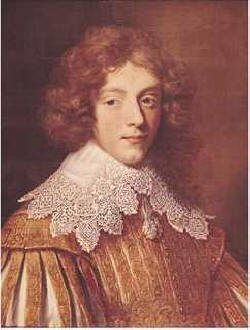

 Henri Coiffier de Ruzé, Marquis of Cinq-Mars (1620 – 12 September 1642) was a favourite of King
Louis XIII of France, who led the last and most nearly successful of many conspiracies against the Cardinal Richelieu, the king's powerful first minister.
Gédéon Tallemant des Réaux is an important source of information on Louis
XIII. He suggests that Marie de’ Médici had deliberately attempted to enfeeble
her son by rendering him effeminate (as it was suggested Anne of Austria later
did in the case of
Philippe d'Orléans). The king's first affections were for Saint-Amour, his
coach driver, then Haran, his kennel-master. After which came
Charles
d'Albert, duc de Luynes, then
François de Baradas and
Monsieur de Cinq-Mars (allegedly selected for him as an amusement by Cardinal
Richelieu). The king drew Cinq-Mars into bed as early as seven o'clock,
Tallemant reported in his Historiettes (not published until 1834), and was
seen covering his hands with kisses before he could get in. When at war, Louis
XIII had reports of Cinq-Mars's health sent several times a day. None of this
prevented Cinq-Mars being beheaded.
Henri Coiffier de Ruzé, Marquis of Cinq-Mars (1620 – 12 September 1642) was a favourite of King
Louis XIII of France, who led the last and most nearly successful of many conspiracies against the Cardinal Richelieu, the king's powerful first minister.
Gédéon Tallemant des Réaux is an important source of information on Louis
XIII. He suggests that Marie de’ Médici had deliberately attempted to enfeeble
her son by rendering him effeminate (as it was suggested Anne of Austria later
did in the case of
Philippe d'Orléans). The king's first affections were for Saint-Amour, his
coach driver, then Haran, his kennel-master. After which came
Charles
d'Albert, duc de Luynes, then
François de Baradas and
Monsieur de Cinq-Mars (allegedly selected for him as an amusement by Cardinal
Richelieu). The king drew Cinq-Mars into bed as early as seven o'clock,
Tallemant reported in his Historiettes (not published until 1834), and was
seen covering his hands with kisses before he could get in. When at war, Louis
XIII had reports of Cinq-Mars's health sent several times a day. None of this
prevented Cinq-Mars being beheaded.
Cinq-Mars was the son of Marshal Antoine Coiffier de Ruzé, marquis d'Effiat, a close friend of Cardinal Richelieu, who took the boy under his protection on his father's death in 1632.
As the son of the marquis d'Effiat, a famous Superintendent of Finances who was also a good friend of Richelieu's, Cinq-Mars came to court very early. In 1639, after the exile of the royal favourite Marie de Hautefort, Richelieu introduced the young Cinq-Mars to Louis, hoping he would find favour with the king, thus allowing Richelieu to exercise even greater control over the king. Cinq-Mars indeed quickly established himself as a royal favourite, and was raised to Grand Squire of France. The cardinal believed he could easily control Cinq-Mars, but instead Cinq-Mars pressed the king for important favours and tried to convince the king to have Richelieu executed. In 1641, Cinq-Mars was active in the Comte de Soissons' rebellion, but the effort failed. The next year, he conspired again with the king's brother, Gaston, Duke of Orleans, to try to get support for the rebellion from Philip IV, the king of Spain; Richelieu's spy service caught him doing so. Consequently, Richelieu had Cinq-Mars imprisoned and beheaded in the Place des Terreaux in Lyon, along with his accomplice, François Auguste de Thou. The French writer, Tallemant, relates that the king showed no emotions concerning the execution: he said "Je voudrais bien voir la grimace qu'il fait à cette heure sur cet échafaud" ('I would like to see the grimace he is now making on this scaffold'). The Marquis of Cinq-Mars' last words were, "Mon Dieu! Qu’est-ce que ce monde" ('My God! What is this world').[1]
Alfred de Vigny wrote a novel Cinq-Mars, inspired by the story of the marquis,[2] and published in 1826. Charles Gounod wrote an opera of the same name which premiered on April 5, 1877. Barbara Strozzi composed a cantata about the execution of the marquis ("Il lamento sul Rodano severo"). A famous historical painting by Paul Delaroche shows Cardinal Richelieu in a gorgeous barge, preceding the boat carrying Cinq-Mars and De Thou to their execution. Historical accounts are Jeanne-Pauline Basserie, La conjuration de Cinq-Mars (Paris, 1896) and Anaïs Bazin, Histoire de France sous Louis XIII (Paris).[3]
My published books: